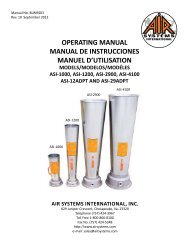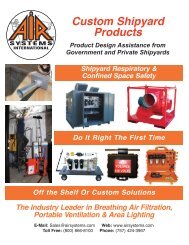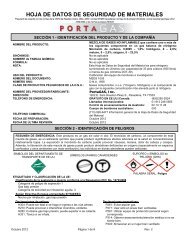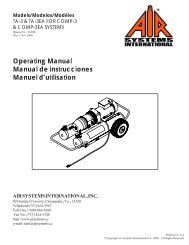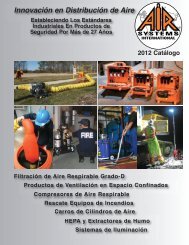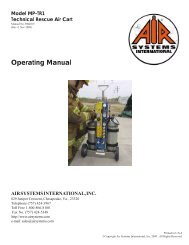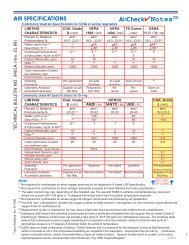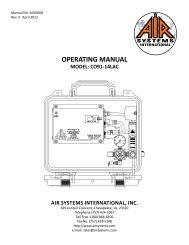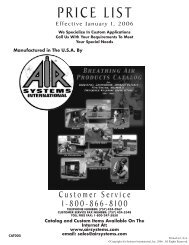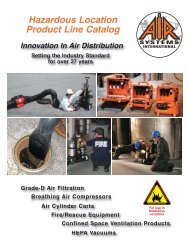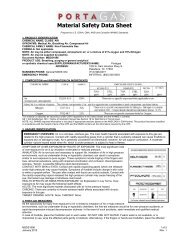OSHA, Respiratory Standard 1910.134 - Air Systems International
OSHA, Respiratory Standard 1910.134 - Air Systems International
OSHA, Respiratory Standard 1910.134 - Air Systems International
You also want an ePaper? Increase the reach of your titles
YUMPU automatically turns print PDFs into web optimized ePapers that Google loves.
<strong>Respiratory</strong> Protection. - <strong>1910.134</strong><br />
http://www.osha.gov/pls/oshaweb/owadisp.show_document?p_table=STANDARDS&p_id...<br />
navigational links] Search<br />
Page 1 of 27<br />
9/27/2005<br />
U.S. Department of Labor<br />
Occupational Safety & Health Administration<br />
www.osha.gov My<strong>OSHA</strong> [skip<br />
Advanced Search | A<br />
Regulations (<strong>Standard</strong>s - 29 CFR)<br />
<strong>Respiratory</strong> Protection. - <strong>1910.134</strong><br />
Regulations (<strong>Standard</strong>s - 29 CFR) - Table of Contents<br />
• Part Number: 1910<br />
• Part Title:<br />
Occupational Safety and Health <strong>Standard</strong>s<br />
• Subpart:<br />
I<br />
• Subpart Title:<br />
Personal Protective Equipment<br />
• <strong>Standard</strong> Number: <strong>1910.134</strong><br />
• Title:<br />
<strong>Respiratory</strong> Protection.<br />
• Appendix:<br />
A , B-1 , B-2 , C , D<br />
This section applies to General Industry (part 1910), Shipyards (part 1915),<br />
Marine Terminals (part 1917), Longshoring (part 1918), and Construction (part<br />
1926).<br />
..<strong>1910.134</strong>(a)<br />
<strong>1910.134</strong>(a)<br />
Permissible practice.<br />
<strong>1910.134</strong>(a)(1)<br />
In the control of those occupational diseases caused by breathing air<br />
contaminated with harmful dusts, fogs, fumes, mists, gases, smokes, sprays, or<br />
vapors, the primary objective shall be to prevent atmospheric contamination.<br />
This shall be accomplished as far as feasible by accepted engineering control<br />
measures (for example, enclosure or confinement of the operation, general and<br />
local ventilation, and substitution of less toxic materials). When effective<br />
engineering controls are not feasible, or while they are being instituted,<br />
appropriate respirators shall be used pursuant to this section.<br />
<strong>1910.134</strong>(a)(2)<br />
Respirators shall be provided by the employer when such equipment is<br />
necessary to protect the health of the employee. The employer shall provide the<br />
respirators which are applicable and suitable for the purpose intended. The<br />
employer shall be responsible for the establishment and maintenance of a<br />
respiratory protection program which shall include the requirements outlined in<br />
paragraph (c) of this section.<br />
<strong>1910.134</strong>(b)<br />
Definitions. The following definitions are important terms used in the<br />
respiratory protection standard in this section.<br />
<strong>Air</strong>-purifying respirator means a respirator with an air-purifying filter,
<strong>Respiratory</strong> Protection. - <strong>1910.134</strong><br />
http://www.osha.gov/pls/oshaweb/owadisp.show_document?p_table=STANDARDS&p_id...<br />
Page 2 of 27<br />
9/27/2005<br />
cartridge, or canister that removes specific air contaminants by passing ambient<br />
air through the air-purifying element.<br />
Assigned protection factor (APF) [Reserved]<br />
Atmosphere-supplying respirator means a respirator that supplies the<br />
respirator user with breathing air from a source independent of the ambient<br />
atmosphere, and includes supplied-air respirators (SARs) and self-contained<br />
breathing apparatus (SCBA) units.<br />
Canister or cartridge means a container with a filter, sorbent, or catalyst, or<br />
combination of these items, which removes specific contaminants from the air<br />
passed through the container.<br />
Demand respirator means an atmosphere-supplying respirator that admits<br />
breathing air to the facepiece only when a negative pressure is created inside<br />
the facepiece by inhalation.<br />
Emergency situation means any occurrence such as, but not limited to,<br />
equipment failure, rupture of containers, or failure of control equipment that<br />
may or does result in an uncontrolled significant release of an airborne<br />
contaminant.<br />
Employee exposure means exposure to a concentration of an airborne<br />
contaminant that would occur if the employee were not using respiratory<br />
protection.<br />
End-of-service-life indicator (ESLI) means a system that warns the<br />
respirator user of the approach of the end of adequate respiratory protection,<br />
for example, that the sorbent is approaching saturation or is no longer effective.<br />
Escape-only respirator means a respirator intended to be used only for<br />
emergency exit.<br />
Filter or air purifying element means a component used in respirators to<br />
remove solid or liquid aerosols from the inspired air.<br />
Filtering facepiece (dust mask) means a negative pressure particulate<br />
respirator with a filter as an integral part of the facepiece or with the entire<br />
facepiece composed of the filtering medium.<br />
Fit factor means a quantitative estimate of the fit of a particular respirator to a<br />
specific individual, and typically estimates the ratio of the concentration of a<br />
substance in ambient air to its concentration inside the respirator when worn.<br />
Fit test means the use of a protocol to qualitatively or quantitatively evaluate<br />
the fit of a respirator on an individual. (See also Qualitative fit test QLFT and<br />
Quantitative fit test QNFT.)<br />
Helmet means a rigid respiratory inlet covering that also provides head<br />
protection against impact and penetration.<br />
High efficiency particulate air (HEPA) filter means a filter that is at least<br />
99.97% efficient in removing monodisperse particles of 0.3 micrometers in<br />
diameter. The equivalent NIOSH 42 CFR 84 particulate filters are the N100,<br />
R100, and P100 filters.
<strong>Respiratory</strong> Protection. - <strong>1910.134</strong><br />
http://www.osha.gov/pls/oshaweb/owadisp.show_document?p_table=STANDARDS&p_id...<br />
Page 3 of 27<br />
9/27/2005<br />
Hood means a respiratory inlet covering that completely covers the head and<br />
neck and may also cover portions of the shoulders and torso.<br />
Immediately dangerous to life or health (IDLH) means an atmosphere<br />
that poses an immediate threat to life, would cause irreversible adverse health<br />
effects, or would impair an individual's ability to escape from a dangerous<br />
atmosphere.<br />
Interior structural firefighting means the physical activity of fire<br />
suppression, rescue or both, inside of buildings or enclosed structures which are<br />
involved in a fire situation beyond the incipient stage. (See 29 CFR 1910.155)<br />
Loose-fitting facepiece means a respiratory inlet covering that is designed to<br />
form a partial seal with the face.<br />
Maximum use concentration (MUC) [Reserved].<br />
Negative pressure respirator (tight fitting) means a respirator in which the<br />
air pressure inside the facepiece is negative during inhalation with respect to<br />
the ambient air pressure outside the respirator.<br />
Oxygen deficient atmosphere means an atmosphere with an oxygen content<br />
below 19.5% by volume.<br />
Physician or other licensed health care professional (PLHCP) means an<br />
individual whose legally permitted scope of practice (i.e., license, registration,<br />
or certification) allows him or her to independently provide, or be delegated the<br />
responsibility to provide, some or all of the health care services required by<br />
paragraph (e) of this section.<br />
Positive pressure respirator means a respirator in which the pressure inside<br />
the respiratory inlet covering exceeds the ambient air pressure outside the<br />
respirator.<br />
Powered air-purifying respirator (PAPR) means an air-purifying respirator<br />
that uses a blower to force the ambient air through air-purifying elements to<br />
the inlet covering.<br />
Pressure demand respirator means a positive pressure atmospheresupplying<br />
respirator that admits breathing air to the facepiece when the positive<br />
pressure is reduced inside the facepiece by inhalation.<br />
Qualitative fit test (QLFT) means a pass/fail fit test to assess the adequacy<br />
of respirator fit that relies on the individual's response to the test agent.<br />
Quantitative fit test (QNFT) means an assessment of the adequacy of<br />
respirator fit by numerically measuring the amount of leakage into the<br />
respirator.<br />
<strong>Respiratory</strong> inlet covering means that portion of a respirator that forms the<br />
protective barrier between the user's respiratory tract and an air-purifying<br />
device or breathing air source, or both. It may be a facepiece, helmet, hood,<br />
suit, or a mouthpiece respirator with nose clamp.<br />
Self-contained breathing apparatus (SCBA) means an atmospheresupplying<br />
respirator for which the breathing air source is designed to be carried<br />
by the user.
<strong>Respiratory</strong> Protection. - <strong>1910.134</strong><br />
http://www.osha.gov/pls/oshaweb/owadisp.show_document?p_table=STANDARDS&p_id...<br />
Page 4 of 27<br />
9/27/2005<br />
Service life means the period of time that a respirator, filter or sorbent, or<br />
other respiratory equipment provides adequate protection to the wearer.<br />
Supplied-air respirator (SAR) or airline respirator means an atmospheresupplying<br />
respirator for which the source of breathing air is not designed to be<br />
carried by the user.<br />
This section means this respiratory protection standard.<br />
Tight-fitting facepiece means a respiratory inlet covering that forms a<br />
complete seal with the face.<br />
User seal check means an action conducted by the respirator user to<br />
determine if the respirator is properly seated to the face.<br />
<strong>1910.134</strong>(c)<br />
<strong>Respiratory</strong> protection program. This paragraph requires the employer to<br />
develop and implement a written respiratory protection program with required<br />
worksite-specific procedures and elements for required respirator use. The<br />
program must be administered by a suitably trained program administrator. In<br />
addition, certain program elements may be required for voluntary use to<br />
prevent potential hazards associated with the use of the respirator. The Small<br />
Entity Compliance Guide contains criteria for the selection of a program<br />
administrator and a sample program that meets the requirements of this<br />
paragraph. Copies of the Small Entity Compliance Guide will be available on or<br />
about April 8, 1998 from the Occupational Safety and Health Administration's<br />
Office of Publications, Room N 3101, 200 Constitution Avenue, NW,<br />
Washington, DC, 20210 (202-219-4667).<br />
<strong>1910.134</strong>(c)(1)<br />
In any workplace where respirators are necessary to protect the health of the<br />
employee or whenever respirators are required by the employer, the employer<br />
shall establish and implement a written respiratory protection program with<br />
worksite-specific procedures. The program shall be updated as necessary to<br />
reflect those changes in workplace conditions that affect respirator use. The<br />
employer shall include in the program the following provisions of this section, as<br />
applicable:<br />
<strong>1910.134</strong>(c)(1)(i)<br />
Procedures for selecting respirators for use in the workplace;<br />
<strong>1910.134</strong>(c)(1)(ii)<br />
Medical evaluations of employees required to use respirators;<br />
<strong>1910.134</strong>(c)(1)(iii)<br />
Fit testing procedures for tight-fitting respirators;<br />
<strong>1910.134</strong>(c)(1)(iv)<br />
Procedures for proper use of respirators in routine and reasonably foreseeable
<strong>Respiratory</strong> Protection. - <strong>1910.134</strong><br />
http://www.osha.gov/pls/oshaweb/owadisp.show_document?p_table=STANDARDS&p_id...<br />
Page 5 of 27<br />
9/27/2005<br />
emergency situations;<br />
<strong>1910.134</strong>(c)(1)(v)<br />
Procedures and schedules for cleaning, disinfecting, storing, inspecting,<br />
repairing, discarding, and otherwise maintaining respirators;<br />
<strong>1910.134</strong>(c)(1)(vi)<br />
Procedures to ensure adequate air quality, quantity, and flow of breathing air<br />
for atmosphere-supplying respirators;<br />
<strong>1910.134</strong>(c)(1)(vii)<br />
Training of employees in the respiratory hazards to which they are potentially<br />
exposed during routine and emergency situations;<br />
..<strong>1910.134</strong>(c)(1)(viii)<br />
<strong>1910.134</strong>(c)(1)(viii)<br />
Training of employees in the proper use of respirators, including putting on and<br />
removing them, any limitations on their use, and their maintenance; and<br />
<strong>1910.134</strong>(c)(1)(ix)<br />
Procedures for regularly evaluating the effectiveness of the program.<br />
<strong>1910.134</strong>(c)(2)<br />
Where respirator use is not required:<br />
<strong>1910.134</strong>(c)(2)(i)<br />
An employer may provide respirators at the request of employees or permit<br />
employees to use their own respirators, if the employer determines that such<br />
respirator use will not in itself create a hazard. If the employer determines that<br />
any voluntary respirator use is permissible, the employer shall provide the<br />
respirator users with the information contained in Appendix D to this section<br />
("Information for Employees Using Respirators When Not Required Under the<br />
<strong>Standard</strong>"); and<br />
<strong>1910.134</strong>(c)(2)(ii)<br />
In addition, the employer must establish and implement those elements of a<br />
written respiratory protection program necessary to ensure that any employee<br />
using a respirator voluntarily is medically able to use that respirator, and that<br />
the respirator is cleaned, stored, and maintained so that its use does not<br />
present a health hazard to the user. Exception: Employers are not required to<br />
include in a written respiratory protection program those employees whose only<br />
use of respirators involves the voluntary use of filtering facepieces (dust<br />
masks).<br />
<strong>1910.134</strong>(c)(3)
<strong>Respiratory</strong> Protection. - <strong>1910.134</strong><br />
http://www.osha.gov/pls/oshaweb/owadisp.show_document?p_table=STANDARDS&p_id...<br />
Page 6 of 27<br />
9/27/2005<br />
The employer shall designate a program administrator who is qualified by<br />
appropriate training or experience that is commensurate with the complexity of<br />
the program to administer or oversee the respiratory protection program and<br />
conduct the required evaluations of program effectiveness.<br />
<strong>1910.134</strong>(c)(4)<br />
The employer shall provide respirators, training, and medical evaluations at no<br />
cost to the employee.<br />
<strong>1910.134</strong>(d)<br />
Selection of respirators. This paragraph requires the employer to evaluate<br />
respiratory hazard(s) in the workplace, identify relevant workplace and user<br />
factors, and base respirator selection on these factors. The paragraph also<br />
specifies appropriately protective respirators for use in IDLH atmospheres, and<br />
limits the selection and use of air-purifying respirators.<br />
<strong>1910.134</strong>(d)(1)<br />
General requirements.<br />
<strong>1910.134</strong>(d)(1)(i)<br />
The employer shall select and provide an appropriate respirator based on the<br />
respiratory hazard(s) to which the worker is exposed and workplace and user<br />
factors that affect respirator performance and reliability.<br />
<strong>1910.134</strong>(d)(1)(ii)<br />
The employer shall select a NIOSH-certified respirator. The respirator shall be<br />
used in compliance with the conditions of its certification.<br />
<strong>1910.134</strong>(d)(1)(iii)<br />
The employer shall identify and evaluate the respiratory hazard(s) in the<br />
workplace; this evaluation shall include a reasonable estimate of employee<br />
exposures to respiratory hazard(s) and an identification of the contaminant's<br />
chemical state and physical form. Where the employer cannot identify or<br />
reasonably estimate the employee exposure, the employer shall consider the<br />
atmosphere to be IDLH.<br />
..<strong>1910.134</strong>(d)(1)(iv)<br />
<strong>1910.134</strong>(d)(1)(iv)<br />
The employer shall select respirators from a sufficient number of respirator<br />
models and sizes so that the respirator is acceptable to, and correctly fits, the<br />
user.<br />
<strong>1910.134</strong>(d)(2)<br />
Respirators for IDLH atmospheres.
<strong>Respiratory</strong> Protection. - <strong>1910.134</strong><br />
http://www.osha.gov/pls/oshaweb/owadisp.show_document?p_table=STANDARDS&p_id...<br />
Page 7 of 27<br />
9/27/2005<br />
<strong>1910.134</strong>(d)(2)(i)<br />
The employer shall provide the following respirators for employee use in IDLH<br />
atmospheres:<br />
<strong>1910.134</strong>(d)(2)(i)(A)<br />
A full facepiece pressure demand SCBA certified by NIOSH for a minimum<br />
service life of thirty minutes, or<br />
<strong>1910.134</strong>(d)(2)(i)(B)<br />
A combination full facepiece pressure demand supplied-air respirator (SAR) with<br />
auxiliary self-contained air supply.<br />
<strong>1910.134</strong>(d)(2)(ii)<br />
Respirators provided only for escape from IDLH atmospheres shall be NIOSHcertified<br />
for escape from the atmosphere in which they will be used.<br />
<strong>1910.134</strong>(d)(2)(iii)<br />
All oxygen-deficient atmospheres shall be considered IDLH. Exception: If the<br />
employer demonstrates that, under all foreseeable conditions, the oxygen<br />
concentration can be maintained within the ranges specified in Table II of this<br />
section (i.e., for the altitudes set out in the table), then any atmospheresupplying<br />
respirator may be used.<br />
<strong>1910.134</strong>(d)(3)<br />
Respirators for atmospheres that are not IDLH.<br />
<strong>1910.134</strong>(d)(3)(i)<br />
The employer shall provide a respirator that is adequate to protect the health of<br />
the employee and ensure compliance with all other <strong>OSHA</strong> statutory and<br />
regulatory requirements, under routine and reasonably foreseeable emergency<br />
situations.<br />
<strong>1910.134</strong>(d)(3)(i)(A)<br />
Assigned Protection Factors (APFs) [Reserved]<br />
<strong>1910.134</strong>(d)(3)(i)(B)<br />
Maximum Use Concentration (MUC) [Reserved]<br />
<strong>1910.134</strong>(d)(3)(ii)<br />
The respirator selected shall be appropriate for the chemical state and physical<br />
form of the contaminant.<br />
<strong>1910.134</strong>(d)(3)(iii)
<strong>Respiratory</strong> Protection. - <strong>1910.134</strong><br />
http://www.osha.gov/pls/oshaweb/owadisp.show_document?p_table=STANDARDS&p_id...<br />
Page 8 of 27<br />
9/27/2005<br />
For protection against gases and vapors, the employer shall provide:<br />
<strong>1910.134</strong>(d)(3)(iii)(A)<br />
An atmosphere-supplying respirator, or<br />
<strong>1910.134</strong>(d)(3)(iii)(B)<br />
An air-purifying respirator, provided that:<br />
<strong>1910.134</strong>(d)(3)(iii)(B)(1)<br />
The respirator is equipped with an end-of-service-life indicator (ESLI) certified<br />
by NIOSH for the contaminant; or<br />
<strong>1910.134</strong>(d)(3)(iii)(B)(2)<br />
If there is no ESLI appropriate for conditions in the employer's workplace, the<br />
employer implements a change schedule for canisters and cartridges that is<br />
based on objective information or data that will ensure that canisters and<br />
cartridges are changed before the end of their service life. The employer shall<br />
describe in the respirator program the information and data relied upon and the<br />
basis for the canister and cartridge change schedule and the basis for reliance<br />
on the data.<br />
<strong>1910.134</strong>(d)(3)(iv)<br />
For protection against particulates, the employer shall provide:<br />
<strong>1910.134</strong>(d)(3)(iv)(A)<br />
An atmosphere-supplying respirator; or<br />
<strong>1910.134</strong>(d)(3)(iv)(B)<br />
An air-purifying respirator equipped with a filter certified by NIOSH under 30<br />
CFR part 11 as a high efficiency particulate air (HEPA) filter, or an air-purifying<br />
respirator equipped with a filter certified for particulates by NIOSH under 42<br />
CFR part 84; or<br />
<strong>1910.134</strong>(d)(3)(iv)(C)<br />
For contaminants consisting primarily of particles with mass median<br />
aerodynamic diameters (MMAD) of at least 2 micrometers, an air-purifying<br />
respirator equipped with any filter certified for particulates by NIOSH.<br />
TABLE I. -- ASSIGNED PROTECTION FACTORS<br />
[RESERVED]<br />
TABLE II
<strong>Respiratory</strong> Protection. - <strong>1910.134</strong><br />
http://www.osha.gov/pls/oshaweb/owadisp.show_document?p_table=STANDARDS&p_id...<br />
Page 9 of 27<br />
9/27/2005<br />
Oxygen<br />
deficient<br />
Atmospheres<br />
(% 0 2<br />
) for<br />
Altitude (ft.)<br />
which the<br />
employer<br />
atmospheremay<br />
rely on<br />
supplying<br />
respirators<br />
Less than 3,001<br />
16.0-19.5<br />
3,001-4,000<br />
16.4-19.5<br />
4,001-5,000<br />
17.1-19.5<br />
5,001-6,000<br />
17.8-19.5<br />
6,001-7,000<br />
18.5-19.5<br />
7,001-8,000 1 19.3-19.5.<br />
1 Above 8,000 feet the exception does not apply. Oxygenenriched<br />
breathing air must be supplied above 14,000 feet.<br />
<strong>1910.134</strong>(e)<br />
Medical evaluation. Using a respirator may place a physiological burden on<br />
employees that varies with the type of respirator worn, the job and workplace<br />
conditions in which the respirator is used, and the medical status of the<br />
employee. Accordingly, this paragraph specifies the minimum requirements for<br />
medical evaluation that employers must implement to determine the<br />
employee's ability to use a respirator.<br />
<strong>1910.134</strong>(e)(1)<br />
General. The employer shall provide a medical evaluation to determine the<br />
employee's ability to use a respirator, before the employee is fit tested or<br />
required to use the respirator in the workplace. The employer may discontinue<br />
an employee's medical evaluations when the employee is no longer required to<br />
use a respirator.<br />
<strong>1910.134</strong>(e)(2)<br />
Medical evaluation procedures.<br />
<strong>1910.134</strong>(e)(2)(i)<br />
The employer shall identify a physician or other licensed health care<br />
professional (PLHCP) to perform medical evaluations using a medical<br />
questionnaire or an initial medical examination that obtains the same<br />
information as the medical questionnaire.<br />
<strong>1910.134</strong>(e)(2)(ii)<br />
The medical evaluation shall obtain the information requested by the<br />
questionnaire in Sections 1 and 2, Part A of Appendix C of this section.<br />
<strong>1910.134</strong>(e)(3)
<strong>Respiratory</strong> Protection. - <strong>1910.134</strong><br />
http://www.osha.gov/pls/oshaweb/owadisp.show_document?p_table=STANDARDS&p_id...<br />
Page 10 of 27<br />
9/27/2005<br />
Follow-up medical examination.<br />
<strong>1910.134</strong>(e)(3)(i)<br />
The employer shall ensure that a follow-up medical examination is provided for<br />
an employee who gives a positive response to any question among questions 1<br />
through 8 in Section 2, Part A of Appendix C or whose initial medical<br />
examination demonstrates the need for a follow-up medical examination.<br />
<strong>1910.134</strong>(e)(3)(ii)<br />
The follow-up medical examination shall include any medical tests,<br />
consultations, or diagnostic procedures that the PLHCP deems necessary to<br />
make a final determination.<br />
<strong>1910.134</strong>(e)(4)<br />
Administration of the medical questionnaire and examinations.<br />
<strong>1910.134</strong>(e)(4)(i)<br />
The medical questionnaire and examinations shall be administered confidentially<br />
during the employee's normal working hours or at a time and place convenient<br />
to the employee. The medical questionnaire shall be administered in a manner<br />
that ensures that the employee understands its content.<br />
<strong>1910.134</strong>(e)(4)(ii)<br />
The employer shall provide the employee with an opportunity to discuss the<br />
questionnaire and examination results with the PLHCP.<br />
<strong>1910.134</strong>(e)(5)<br />
Supplemental information for the PLHCP.<br />
<strong>1910.134</strong>(e)(5)(i)<br />
The following information must be provided to the PLHCP before the PLHCP<br />
makes a recommendation concerning an employee's ability to use a respirator:<br />
<strong>1910.134</strong>(e)(5)(i)(A)<br />
(A) The type and weight of the respirator to be used by the employee;<br />
<strong>1910.134</strong>(e)(5)(i)(B)<br />
The duration and frequency of respirator use (including use for rescue and<br />
escape);<br />
<strong>1910.134</strong>(e)(5)(i)(C)<br />
The expected physical work effort;
<strong>Respiratory</strong> Protection. - <strong>1910.134</strong><br />
http://www.osha.gov/pls/oshaweb/owadisp.show_document?p_table=STANDARDS&p_id...<br />
Page 11 of 27<br />
9/27/2005<br />
<strong>1910.134</strong>(e)(5)(i)(D)<br />
Additional protective clothing and equipment to be worn; and<br />
<strong>1910.134</strong>(e)(5)(i)(E)<br />
Temperature and humidity extremes that may be encountered.<br />
<strong>1910.134</strong>(e)(5)(ii)<br />
Any supplemental information provided previously to the PLHCP regarding an<br />
employee need not be provided for a subsequent medical evaluation if the<br />
information and the PLHCP remain the same.<br />
<strong>1910.134</strong>(e)(5)(iii)<br />
The employer shall provide the PLHCP with a copy of the written respiratory<br />
protection program and a copy of this section.<br />
Note to Paragraph (e)(5)(iii): When the employer replaces a PLHCP, the<br />
employer must ensure that the new PLHCP obtains this information, either by<br />
providing the documents directly to the PLHCP or having the documents<br />
transferred from the former PLHCP to the new PLHCP. However, <strong>OSHA</strong> does not<br />
expect employers to have employees medically reevaluated solely because a<br />
new PLHCP has been selected.<br />
<strong>1910.134</strong>(e)(6)<br />
Medical determination. In determining the employee's ability to use a<br />
respirator, the employer shall:<br />
<strong>1910.134</strong>(e)(6)(i)<br />
Obtain a written recommendation regarding the employee's ability to use the<br />
respirator from the PLHCP. The recommendation shall provide only the following<br />
information:<br />
<strong>1910.134</strong>(e)(6)(i)(A)<br />
Any limitations on respirator use related to the medical condition of the<br />
employee, or relating to the workplace conditions in which the respirator will be<br />
used, including whether or not the employee is medically able to use the<br />
respirator;<br />
<strong>1910.134</strong>(e)(6)(i)(B)<br />
The need, if any, for follow-up medical evaluations; and<br />
<strong>1910.134</strong>(e)(6)(i)(C)<br />
A statement that the PLHCP has provided the employee with a copy of the<br />
PLHCP's written recommendation.<br />
<strong>1910.134</strong>(e)(6)(ii)
<strong>Respiratory</strong> Protection. - <strong>1910.134</strong><br />
http://www.osha.gov/pls/oshaweb/owadisp.show_document?p_table=STANDARDS&p_id...<br />
Page 12 of 27<br />
9/27/2005<br />
If the respirator is a negative pressure respirator and the PLHCP finds a medical<br />
condition that may place the employee's health at increased risk if the<br />
respirator is used, the employer shall provide a PAPR if the PLHCP's medical<br />
evaluation finds that the employee can use such a respirator; if a subsequent<br />
medical evaluation finds that the employee is medically able to use a negative<br />
pressure respirator, then the employer is no longer required to provide a PAPR.<br />
<strong>1910.134</strong>(e)(7)<br />
Additional medical evaluations. At a minimum, the employer shall provide<br />
additional medical evaluations that comply with the requirements of this section<br />
if:<br />
<strong>1910.134</strong>(e)(7)(i)<br />
An employee reports medical signs or symptoms that are related to ability to<br />
use a respirator;<br />
<strong>1910.134</strong>(e)(7)(ii)<br />
A PLHCP, supervisor, or the respirator program administrator informs the<br />
employer that an employee needs to be reevaluated;<br />
<strong>1910.134</strong>(e)(7)(iii)<br />
Information from the respiratory protection program, including observations<br />
made during fit testing and program evaluation, indicates a need for employee<br />
reevaluation; or<br />
<strong>1910.134</strong>(e)(7)(iv)<br />
A change occurs in workplace conditions (e.g., physical work effort, protective<br />
clothing, temperature) that may result in a substantial increase in the<br />
physiological burden placed on an employee.<br />
<strong>1910.134</strong>(f)<br />
Fit testing. This paragraph requires that, before an employee may be required<br />
to use any respirator with a negative or positive pressure tight-fitting facepiece,<br />
the employee must be fit tested with the same make, model, style, and size of<br />
respirator that will be used. This paragraph specifies the kinds of fit tests<br />
allowed, the procedures for conducting them, and how the results of the fit<br />
tests must be used.<br />
<strong>1910.134</strong>(f)(1)<br />
The employer shall ensure that employees using a tight-fitting facepiece<br />
respirator pass an appropriate qualitative fit test (QLFT) or quantitative fit test<br />
(QNFT) as stated in this paragraph.<br />
<strong>1910.134</strong>(f)(2)<br />
The employer shall ensure that an employee using a tight-fitting facepiece<br />
respirator is fit tested prior to initial use of the respirator, whenever a different<br />
respirator facepiece (size, style, model or make) is used, and at least annually
<strong>Respiratory</strong> Protection. - <strong>1910.134</strong><br />
http://www.osha.gov/pls/oshaweb/owadisp.show_document?p_table=STANDARDS&p_id...<br />
Page 13 of 27<br />
9/27/2005<br />
thereafter.<br />
<strong>1910.134</strong>(f)(3)<br />
The employer shall conduct an additional fit test whenever the employee<br />
reports, or the employer, PLHCP, supervisor, or program administrator makes<br />
visual observations of, changes in the employee's physical condition that could<br />
affect respirator fit. Such conditions include, but are not limited to, facial<br />
scarring, dental changes, cosmetic surgery, or an obvious change in body<br />
weight.<br />
<strong>1910.134</strong>(f)(4)<br />
If after passing a QLFT or QNFT, the employee subsequently notifies the<br />
employer, program administrator, supervisor, or PLHCP that the fit of the<br />
respirator is unacceptable, the employee shall be given a reasonable<br />
opportunity to select a different respirator facepiece and to be retested.<br />
..<strong>1910.134</strong>(f)(5)<br />
<strong>1910.134</strong>(f)(5)<br />
The fit test shall be administered using an <strong>OSHA</strong>-accepted QLFT or QNFT<br />
protocol. The <strong>OSHA</strong>-accepted QLFT and QNFT protocols and procedures are<br />
contained in Appendix A of this section.<br />
<strong>1910.134</strong>(f)(6)<br />
QLFT may only be used to fit test negative pressure air-purifying respirators<br />
that must achieve a fit factor of 100 or less.<br />
<strong>1910.134</strong>(f)(7)<br />
If the fit factor, as determined through an <strong>OSHA</strong>-accepted QNFT protocol, is<br />
equal to or greater than 100 for tight-fitting half facepieces, or equal to or<br />
greater than 500 for tight-fitting full facepieces, the QNFT has been passed with<br />
that respirator.<br />
<strong>1910.134</strong>(f)(8)<br />
Fit testing of tight-fitting atmosphere-supplying respirators and tight-fitting<br />
powered air-purifying respirators shall be accomplished by performing<br />
quantitative or qualitative fit testing in the negative pressure mode, regardless<br />
of the mode of operation (negative or positive pressure) that is used for<br />
respiratory protection.<br />
<strong>1910.134</strong>(f)(8)(i)<br />
Qualitative fit testing of these respirators shall be accomplished by temporarily<br />
converting the respirator user's actual facepiece into a negative pressure<br />
respirator with appropriate filters, or by using an identical negative pressure<br />
air-purifying respirator facepiece with the same sealing surfaces as a surrogate<br />
for the atmosphere-supplying or powered air-purifying respirator facepiece.<br />
<strong>1910.134</strong>(f)(8)(ii)
<strong>Respiratory</strong> Protection. - <strong>1910.134</strong><br />
http://www.osha.gov/pls/oshaweb/owadisp.show_document?p_table=STANDARDS&p_id...<br />
Page 14 of 27<br />
9/27/2005<br />
Quantitative fit testing of these respirators shall be accomplished by modifying<br />
the facepiece to allow sampling inside the facepiece in the breathing zone of the<br />
user, midway between the nose and mouth. This requirement shall be<br />
accomplished by installing a permanent sampling probe onto a surrogate<br />
facepiece, or by using a sampling adapter designed to temporarily provide a<br />
means of sampling air from inside the facepiece.<br />
<strong>1910.134</strong>(f)(8)(iii)<br />
Any modifications to the respirator facepiece for fit testing shall be completely<br />
removed, and the facepiece restored to NIOSH-approved configuration, before<br />
that facepiece can be used in the workplace.<br />
<strong>1910.134</strong>(g)<br />
Use of respirators. This paragraph requires employers to establish and<br />
implement procedures for the proper use of respirators. These requirements<br />
include prohibiting conditions that may result in facepiece seal leakage,<br />
preventing employees from removing respirators in hazardous environments,<br />
taking actions to ensure continued effective respirator operation throughout the<br />
work shift, and establishing procedures for the use of respirators in IDLH<br />
atmospheres or in interior structural firefighting situations.<br />
<strong>1910.134</strong>(g)(1)<br />
Facepiece seal protection.<br />
<strong>1910.134</strong>(g)(1)(i)<br />
The employer shall not permit respirators with tight-fitting facepieces to be<br />
worn by employees who have:<br />
<strong>1910.134</strong>(g)(1)(i)(A)<br />
Facial hair that comes between the sealing surface of the facepiece and the face<br />
or that interferes with valve function; or<br />
<strong>1910.134</strong>(g)(1)(i)(B)<br />
Any condition that interferes with the face-to-facepiece seal or valve function.<br />
<strong>1910.134</strong>(g)(1)(ii)<br />
If an employee wears corrective glasses or goggles or other personal protective<br />
equipment, the employer shall ensure that such equipment is worn in a manner<br />
that does not interfere with the seal of the facepiece to the face of the user.<br />
<strong>1910.134</strong>(g)(1)(iii)<br />
For all tight-fitting respirators, the employer shall ensure that employees<br />
perform a user seal check each time they put on the respirator using the<br />
procedures in Appendix B-1 or procedures recommended by the respirator<br />
manufacturer that the employer demonstrates are as effective as those in<br />
Appendix B-1 of this section.
<strong>Respiratory</strong> Protection. - <strong>1910.134</strong><br />
http://www.osha.gov/pls/oshaweb/owadisp.show_document?p_table=STANDARDS&p_id...<br />
Page 15 of 27<br />
9/27/2005<br />
<strong>1910.134</strong>(g)(2)<br />
Continuing respirator effectiveness.<br />
<strong>1910.134</strong>(g)(2)(i)<br />
Appropriate surveillance shall be maintained of work area conditions and degree<br />
of employee exposure or stress. When there is a change in work area conditions<br />
or degree of employee exposure or stress that may affect respirator<br />
effectiveness, the employer shall reevaluate the continued effectiveness of the<br />
respirator.<br />
<strong>1910.134</strong>(g)(2)(ii)<br />
The employer shall ensure that employees leave the respirator use area:<br />
..<strong>1910.134</strong>(g)(2)(ii)(A)<br />
<strong>1910.134</strong>(g)(2)(ii)(A)<br />
To wash their faces and respirator facepieces as necessary to prevent eye or<br />
skin irritation associated with respirator use; or<br />
<strong>1910.134</strong>(g)(2)(ii)(B)<br />
If they detect vapor or gas breakthrough, changes in breathing resistance, or<br />
leakage of the facepiece; or<br />
<strong>1910.134</strong>(g)(2)(ii)(C)<br />
To replace the respirator or the filter, cartridge, or canister elements.<br />
<strong>1910.134</strong>(g)(2)(iii)<br />
If the employee detects vapor or gas breakthrough, changes in breathing<br />
resistance, or leakage of the facepiece, the employer must replace or repair the<br />
respirator before allowing the employee to return to the work area.<br />
<strong>1910.134</strong>(g)(3)<br />
Procedures for IDLH atmospheres. For all IDLH atmospheres, the employer<br />
shall ensure that:<br />
<strong>1910.134</strong>(g)(3)(i)<br />
One employee or, when needed, more than one employee is located outside the<br />
IDLH atmosphere;<br />
<strong>1910.134</strong>(g)(3)(ii)<br />
Visual, voice, or signal line communication is maintained between the employee<br />
(s) in the IDLH atmosphere and the employee(s) located outside the IDLH<br />
atmosphere;
<strong>Respiratory</strong> Protection. - <strong>1910.134</strong><br />
http://www.osha.gov/pls/oshaweb/owadisp.show_document?p_table=STANDARDS&p_id...<br />
Page 16 of 27<br />
9/27/2005<br />
<strong>1910.134</strong>(g)(3)(iii)<br />
The employee(s) located outside the IDLH atmosphere are trained and<br />
equipped to provide effective emergency rescue;<br />
<strong>1910.134</strong>(g)(3)(iv)<br />
The employer or designee is notified before the employee(s) located outside the<br />
IDLH atmosphere enter the IDLH atmosphere to provide emergency rescue;<br />
<strong>1910.134</strong>(g)(3)(v)<br />
The employer or designee authorized to do so by the employer, once notified,<br />
provides necessary assistance appropriate to the situation;<br />
<strong>1910.134</strong>(g)(3)(vi)<br />
Employee(s) located outside the IDLH atmospheres are equipped with:<br />
<strong>1910.134</strong>(g)(3)(vi)(A)<br />
Pressure demand or other positive pressure SCBAs, or a pressure demand or<br />
other positive pressure supplied-air respirator with auxiliary SCBA; and either<br />
<strong>1910.134</strong>(g)(3)(vi)(B)<br />
Appropriate retrieval equipment for removing the employee(s) who enter(s)<br />
these hazardous atmospheres where retrieval equipment would contribute to<br />
the rescue of the employee(s) and would not increase the overall risk resulting<br />
from entry; or<br />
<strong>1910.134</strong>(g)(3)(vi)(C)<br />
Equivalent means for rescue where retrieval equipment is not required under<br />
paragraph (g)(3)(vi)(B).<br />
<strong>1910.134</strong>(g)(4)<br />
Procedures for interior structural firefighting. In addition to the<br />
requirements set forth under paragraph (g)(3), in interior structural fires, the<br />
employer shall ensure that:<br />
<strong>1910.134</strong>(g)(4)(i)<br />
At least two employees enter the IDLH atmosphere and remain in visual or<br />
voice contact with one another at all times;<br />
<strong>1910.134</strong>(g)(4)(ii)<br />
At least two employees are located outside the IDLH atmosphere; and<br />
<strong>1910.134</strong>(g)(4)(iii)
<strong>Respiratory</strong> Protection. - <strong>1910.134</strong><br />
http://www.osha.gov/pls/oshaweb/owadisp.show_document?p_table=STANDARDS&p_id...<br />
Page 17 of 27<br />
9/27/2005<br />
All employees engaged in interior structural firefighting use SCBAs.<br />
Note 1 to paragraph (g): One of the two individuals located outside the IDLH<br />
atmosphere may be assigned to an additional role, such as incident commander<br />
in charge of the emergency or safety officer, so long as this individual is able to<br />
perform assistance or rescue activities without jeopardizing the safety or health<br />
of any firefighter working at the incident.<br />
Note 2 to paragraph (g): Nothing in this section is meant to preclude<br />
firefighters from performing emergency rescue activities before an entire team<br />
has assembled.<br />
<strong>1910.134</strong>(h)<br />
Maintenance and care of respirators. This paragraph requires the employer<br />
to provide for the cleaning and disinfecting, storage, inspection, and repair of<br />
respirators used by employees.<br />
<strong>1910.134</strong>(h)(1)<br />
Cleaning and disinfecting. The employer shall provide each respirator user<br />
with a respirator that is clean, sanitary, and in good working order. The<br />
employer shall ensure that respirators are cleaned and disinfected using the<br />
procedures in Appendix B-2 of this section, or procedures recommended by the<br />
respirator manufacturer, provided that such procedures are of equivalent<br />
effectiveness. The respirators shall be cleaned and disinfected at the following<br />
intervals:<br />
<strong>1910.134</strong>(h)(1)(i)<br />
Respirators issued for the exclusive use of an employee shall be cleaned and<br />
disinfected as often as necessary to be maintained in a sanitary condition;<br />
<strong>1910.134</strong>(h)(1)(ii)<br />
Respirators issued to more than one employee shall be cleaned and disinfected<br />
before being worn by different individuals;<br />
<strong>1910.134</strong>(h)(1)(iii)<br />
Respirators maintained for emergency use shall be cleaned and disinfected after<br />
each use; and<br />
<strong>1910.134</strong>(h)(1)(iv)<br />
Respirators used in fit testing and training shall be cleaned and disinfected after<br />
each use.<br />
<strong>1910.134</strong>(h)(2)<br />
Storage. The employer shall ensure that respirators are stored as follows:<br />
<strong>1910.134</strong>(h)(2)(i)<br />
All respirators shall be stored to protect them from damage, contamination,
<strong>Respiratory</strong> Protection. - <strong>1910.134</strong><br />
http://www.osha.gov/pls/oshaweb/owadisp.show_document?p_table=STANDARDS&p_id...<br />
Page 18 of 27<br />
9/27/2005<br />
dust, sunlight, extreme temperatures, excessive moisture, and damaging<br />
chemicals, and they shall be packed or stored to prevent deformation of the<br />
facepiece and exhalation valve.<br />
<strong>1910.134</strong>(h)(2)(ii)<br />
In addition to the requirements of paragraph (h)(2)(i) of this section,<br />
emergency respirators shall be:<br />
<strong>1910.134</strong>(h)(2)(ii)(A)<br />
Kept accessible to the work area;<br />
<strong>1910.134</strong>(h)(2)(ii)(B)<br />
Stored in compartments or in covers that are clearly marked as containing<br />
emergency respirators; and<br />
<strong>1910.134</strong>(h)(2)(ii)(C)<br />
Stored in accordance with any applicable manufacturer instructions.<br />
..<strong>1910.134</strong>(h)(3)<br />
<strong>1910.134</strong>(h)(3)<br />
Inspection.<br />
<strong>1910.134</strong>(h)(3)(i)<br />
The employer shall ensure that respirators are inspected as follows:<br />
<strong>1910.134</strong>(h)(3)(i)(A)<br />
All respirators used in routine situations shall be inspected before each use and<br />
during cleaning;<br />
<strong>1910.134</strong>(h)(3)(i)(B)<br />
All respirators maintained for use in emergency situations shall be inspected at<br />
least monthly and in accordance with the manufacturer's recommendations, and<br />
shall be checked for proper function before and after each use; and<br />
<strong>1910.134</strong>(h)(3)(i)(C)<br />
Emergency escape-only respirators shall be inspected before being carried into<br />
the workplace for use.<br />
<strong>1910.134</strong>(h)(3)(ii)<br />
The employer shall ensure that respirator inspections include the following:<br />
<strong>1910.134</strong>(h)(3)(ii)(A)
<strong>Respiratory</strong> Protection. - <strong>1910.134</strong><br />
http://www.osha.gov/pls/oshaweb/owadisp.show_document?p_table=STANDARDS&p_id...<br />
Page 19 of 27<br />
9/27/2005<br />
A check of respirator function, tightness of connections, and the condition of the<br />
various parts including, but not limited to, the facepiece, head straps, valves,<br />
connecting tube, and cartridges, canisters or filters; and<br />
<strong>1910.134</strong>(h)(3)(ii)(B)<br />
A check of elastomeric parts for pliability and signs of deterioration.<br />
<strong>1910.134</strong>(h)(3)(iii)<br />
In addition to the requirements of paragraphs (h)(3)(i) and (ii) of this section,<br />
self-contained breathing apparatus shall be inspected monthly. <strong>Air</strong> and oxygen<br />
cylinders shall be maintained in a fully charged state and shall be recharged<br />
when the pressure falls to 90% of the manufacturer's recommended pressure<br />
level. The employer shall determine that the regulator and warning devices<br />
function properly.<br />
<strong>1910.134</strong>(h)(3)(iv)<br />
For respirators maintained for emergency use, the employer shall:<br />
<strong>1910.134</strong>(h)(3)(iv)(A)<br />
Certify the respirator by documenting the date the inspection was performed,<br />
the name (or signature) of the person who made the inspection, the findings,<br />
required remedial action, and a serial number or other means of identifying the<br />
inspected respirator; and<br />
<strong>1910.134</strong>(h)(3)(iv)(B)<br />
Provide this information on a tag or label that is attached to the storage<br />
compartment for the respirator, is kept with the respirator, or is included in<br />
inspection reports stored as paper or electronic files. This information shall be<br />
maintained until replaced following a subsequent certification.<br />
<strong>1910.134</strong>(h)(4)<br />
Repairs. The employer shall ensure that respirators that fail an inspection or<br />
are otherwise found to be defective are removed from service, and are<br />
discarded or repaired or adjusted in accordance with the following procedures:<br />
<strong>1910.134</strong>(h)(4)(i)<br />
Repairs or adjustments to respirators are to be made only by persons<br />
appropriately trained to perform such operations and shall use only the<br />
respirator manufacturer's NIOSH-approved parts designed for the respirator;<br />
<strong>1910.134</strong>(h)(4)(ii)<br />
Repairs shall be made according to the manufacturer's recommendations and<br />
specifications for the type and extent of repairs to be performed; and<br />
<strong>1910.134</strong>(h)(4)(iii)
<strong>Respiratory</strong> Protection. - <strong>1910.134</strong><br />
http://www.osha.gov/pls/oshaweb/owadisp.show_document?p_table=STANDARDS&p_id...<br />
Page 20 of 27<br />
9/27/2005<br />
Reducing and admission valves, regulators, and alarms shall be adjusted or<br />
repaired only by the manufacturer or a technician trained by the manufacturer.<br />
<strong>1910.134</strong>(i)<br />
Breathing air quality and use. This paragraph requires the employer to<br />
provide employees using atmosphere-supplying respirators (supplied-air and<br />
SCBA) with breathing gases of high purity.<br />
<strong>1910.134</strong>(i)(1)<br />
The employer shall ensure that compressed air, compressed oxygen, liquid air,<br />
and liquid oxygen used for respiration accords with the following specifications:<br />
<strong>1910.134</strong>(i)(1)(i)<br />
Compressed and liquid oxygen shall meet the United States Pharmacopoeia<br />
requirements for medical or breathing oxygen; and<br />
..<strong>1910.134</strong>(i)(1)(ii)<br />
<strong>1910.134</strong>(i)(1)(ii)<br />
Compressed breathing air shall meet at least the requirements for Grade D<br />
breathing air described in ANSI/Compressed Gas Association Commodity<br />
Specification for <strong>Air</strong>, G-7.1-1989, to include:<br />
<strong>1910.134</strong>(i)(1)(ii)(A)<br />
Oxygen content (v/v) of 19.5-23.5%;<br />
<strong>1910.134</strong>(i)(1)(ii)(B)<br />
Hydrocarbon (condensed) content of 5 milligrams per cubic meter of air or less;<br />
<strong>1910.134</strong>(i)(1)(ii)(C)<br />
Carbon monoxide (CO) content of 10 ppm or less;<br />
<strong>1910.134</strong>(i)(1)(ii)(D)<br />
Carbon dioxide content of 1,000 ppm or less; and<br />
<strong>1910.134</strong>(i)(1)(ii)(E)<br />
Lack of noticeable odor.<br />
<strong>1910.134</strong>(i)(2)<br />
The employer shall ensure that compressed oxygen is not used in atmospheresupplying<br />
respirators that have previously used compressed air.<br />
<strong>1910.134</strong>(i)(3)
<strong>Respiratory</strong> Protection. - <strong>1910.134</strong><br />
http://www.osha.gov/pls/oshaweb/owadisp.show_document?p_table=STANDARDS&p_id...<br />
Page 21 of 27<br />
9/27/2005<br />
The employer shall ensure that oxygen concentrations greater than 23.5% are<br />
used only in equipment designed for oxygen service or distribution.<br />
<strong>1910.134</strong>(i)(4)<br />
The employer shall ensure that cylinders used to supply breathing air to<br />
respirators meet the following requirements:<br />
<strong>1910.134</strong>(i)(4)(i)<br />
Cylinders are tested and maintained as prescribed in the Shipping Container<br />
Specification Regulations of the Department of Transportation (49 CFR part 173<br />
and part 178);<br />
<strong>1910.134</strong>(i)(4)(ii)<br />
Cylinders of purchased breathing air have a certificate of analysis from the<br />
supplier that the breathing air meets the requirements for Grade D breathing<br />
air; and<br />
<strong>1910.134</strong>(i)(4)(iii)<br />
The moisture content in the cylinder does not exceed a dew point of -50 deg.F<br />
(-45.6 deg.C) at 1 atmosphere pressure.<br />
<strong>1910.134</strong>(i)(5)<br />
The employer shall ensure that compressors used to supply breathing air to<br />
respirators are constructed and situated so as to:<br />
<strong>1910.134</strong>(i)(5)(i)<br />
Prevent entry of contaminated air into the air-supply system;<br />
<strong>1910.134</strong>(i)(5)(ii)<br />
Minimize moisture content so that the dew point at 1 atmosphere pressure is 10<br />
degrees F (5.56 deg.C) below the ambient temperature;<br />
<strong>1910.134</strong>(i)(5)(iii)<br />
Have suitable in-line air-purifying sorbent beds and filters to further ensure<br />
breathing air quality. Sorbent beds and filters shall be maintained and replaced<br />
or refurbished periodically following the manufacturer's instructions.<br />
<strong>1910.134</strong>(i)(5)(iv)<br />
Have a tag containing the most recent change date and the signature of the<br />
person authorized by the employer to perform the change. The tag shall be<br />
maintained at the compressor.<br />
<strong>1910.134</strong>(i)(6)<br />
For compressors that are not oil-lubricated, the employer shall ensure that
<strong>Respiratory</strong> Protection. - <strong>1910.134</strong><br />
http://www.osha.gov/pls/oshaweb/owadisp.show_document?p_table=STANDARDS&p_id...<br />
Page 22 of 27<br />
9/27/2005<br />
carbon monoxide levels in the breathing air do not exceed 10 ppm.<br />
<strong>1910.134</strong>(i)(7)<br />
For oil-lubricated compressors, the employer shall use a high-temperature or<br />
carbon monoxide alarm, or both, to monitor carbon monoxide levels. If only<br />
high-temperature alarms are used, the air supply shall be monitored at<br />
intervals sufficient to prevent carbon monoxide in the breathing air from<br />
exceeding 10 ppm.<br />
<strong>1910.134</strong>(i)(8)<br />
The employer shall ensure that breathing air couplings are incompatible with<br />
outlets for nonrespirable worksite air or other gas systems. No asphyxiating<br />
substance shall be introduced into breathing air lines.<br />
<strong>1910.134</strong>(i)(9)<br />
The employer shall use breathing gas containers marked in accordance with the<br />
NIOSH respirator certification standard, 42 CFR part 84.<br />
<strong>1910.134</strong>(j)<br />
Identification of filters, cartridges, and canisters. The employer shall<br />
ensure that all filters, cartridges and canisters used in the workplace are labeled<br />
and color coded with the NIOSH approval label and that the label is not<br />
removed and remains legible.<br />
<strong>1910.134</strong>(k)<br />
Training and information. This paragraph requires the employer to provide<br />
effective training to employees who are required to use respirators. The training<br />
must be comprehensive, understandable, and recur annually, and more often if<br />
necessary. This paragraph also requires the employer to provide the basic<br />
information on respirators in Appendix D of this section to employees who wear<br />
respirators when not required by this section or by the employer to do so.<br />
<strong>1910.134</strong>(k)(1)<br />
The employer shall ensure that each employee can demonstrate knowledge of<br />
at least the following:<br />
..<strong>1910.134</strong>(k)(1)(i)<br />
<strong>1910.134</strong>(k)(1)(i)<br />
Why the respirator is necessary and how improper fit, usage, or maintenance<br />
can compromise the protective effect of the respirator;<br />
<strong>1910.134</strong>(k)(1)(ii)<br />
What the limitations and capabilities of the respirator are;<br />
<strong>1910.134</strong>(k)(1)(iii)
<strong>Respiratory</strong> Protection. - <strong>1910.134</strong><br />
http://www.osha.gov/pls/oshaweb/owadisp.show_document?p_table=STANDARDS&p_id...<br />
Page 23 of 27<br />
9/27/2005<br />
How to use the respirator effectively in emergency situations, including<br />
situations in which the respirator malfunctions;<br />
<strong>1910.134</strong>(k)(1)(iv)<br />
How to inspect, put on and remove, use, and check the seals of the respirator;<br />
<strong>1910.134</strong>(k)(1)(v)<br />
What the procedures are for maintenance and storage of the respirator;<br />
<strong>1910.134</strong>(k)(1)(vi)<br />
How to recognize medical signs and symptoms that may limit or prevent the<br />
effective use of respirators; and<br />
<strong>1910.134</strong>(k)(1)(vii)<br />
The general requirements of this section.<br />
<strong>1910.134</strong>(k)(2)<br />
The training shall be conducted in a manner that is understandable to the<br />
employee.<br />
<strong>1910.134</strong>(k)(3)<br />
The employer shall provide the training prior to requiring the employee to use a<br />
respirator in the workplace.<br />
<strong>1910.134</strong>(k)(4)<br />
An employer who is able to demonstrate that a new employee has received<br />
training within the last 12 months that addresses the elements specified in<br />
paragraph (k)(1)(i) through (vii) is not required to repeat such training<br />
provided that, as required by paragraph (k)(1), the employee can demonstrate<br />
knowledge of those element(s). Previous training not repeated initially by the<br />
employer must be provided no later than 12 months from the date of the<br />
previous training.<br />
<strong>1910.134</strong>(k)(5)<br />
Retraining shall be administered annually, and when the following situations<br />
occur:<br />
<strong>1910.134</strong>(k)(5)(i)<br />
Changes in the workplace or the type of respirator render previous training<br />
obsolete;<br />
<strong>1910.134</strong>(k)(5)(ii)<br />
Inadequacies in the employee's knowledge or use of the respirator indicate that<br />
the employee has not retained the requisite understanding or skill; or
<strong>Respiratory</strong> Protection. - <strong>1910.134</strong><br />
http://www.osha.gov/pls/oshaweb/owadisp.show_document?p_table=STANDARDS&p_id...<br />
Page 24 of 27<br />
9/27/2005<br />
<strong>1910.134</strong>(k)(5)(iii)<br />
Any other situation arises in which retraining appears necessary to ensure safe<br />
respirator use.<br />
<strong>1910.134</strong>(k)(6)<br />
The basic advisory information on respirators, as presented in Appendix D of<br />
this section, shall be provided by the employer in any written or oral format, to<br />
employees who wear respirators when such use is not required by this section<br />
or by the employer.<br />
<strong>1910.134</strong>(l)<br />
Program evaluation. This section requires the employer to conduct<br />
evaluations of the workplace to ensure that the written respiratory protection<br />
program is being properly implemented, and to consult employees to ensure<br />
that they are using the respirators properly.<br />
<strong>1910.134</strong>(l)(1)<br />
The employer shall conduct evaluations of the workplace as necessary to ensure<br />
that the provisions of the current written program are being effectively<br />
implemented and that it continues to be effective.<br />
<strong>1910.134</strong>(l)(2)<br />
The employer shall regularly consult employees required to use respirators to<br />
assess the employees' views on program effectiveness and to identify any<br />
problems. Any problems that are identified during this assessment shall be<br />
corrected. Factors to be assessed include, but are not limited to:<br />
..<strong>1910.134</strong>((l)(2)(i)<br />
<strong>1910.134</strong>(l)(2)(i)<br />
Respirator fit (including the ability to use the respirator without interfering with<br />
effective workplace performance);<br />
<strong>1910.134</strong>(l)(2)(ii)<br />
Appropriate respirator selection for the hazards to which the employee is<br />
exposed;<br />
<strong>1910.134</strong>(l)(2)(iii)<br />
Proper respirator use under the workplace conditions the employee encounters;<br />
and<br />
<strong>1910.134</strong>(l)(2)(iv)<br />
Proper respirator maintenance.<br />
<strong>1910.134</strong>(m)
<strong>Respiratory</strong> Protection. - <strong>1910.134</strong><br />
http://www.osha.gov/pls/oshaweb/owadisp.show_document?p_table=STANDARDS&p_id...<br />
Page 25 of 27<br />
9/27/2005<br />
Recordkeeping. This section requires the employer to establish and retain<br />
written information regarding medical evaluations, fit testing, and the respirator<br />
program. This information will facilitate employee involvement in the respirator<br />
program, assist the employer in auditing the adequacy of the program, and<br />
provide a record for compliance determinations by <strong>OSHA</strong>.<br />
..<strong>1910.134</strong>(m)(1)<br />
<strong>1910.134</strong>(m)(1)<br />
Medical evaluation. Records of medical evaluations required by this section<br />
must be retained and made available in accordance with 29 CFR 1910.1020.<br />
<strong>1910.134</strong>(m)(2)<br />
Fit testing.<br />
<strong>1910.134</strong>(m)(2)(i)<br />
The employer shall establish a record of the qualitative and quantitative fit tests<br />
administered to an employee including:<br />
<strong>1910.134</strong>(m)(2)(i)(A)<br />
The name or identification of the employee tested;<br />
<strong>1910.134</strong>(m)(2)(i)(B)<br />
Type of fit test performed;<br />
<strong>1910.134</strong>(m)(2)(i)(C)<br />
Specific make, model, style, and size of respirator tested;<br />
<strong>1910.134</strong>(m)(2)(i)(D)<br />
Date of test; and<br />
<strong>1910.134</strong>(m)(2)(i)(E)<br />
The pass/fail results for QLFTs or the fit factor and strip chart recording or other<br />
recording of the test results for QNFTs.<br />
<strong>1910.134</strong>(m)(2)(ii)<br />
Fit test records shall be retained for respirator users until the next fit test is<br />
administered.<br />
<strong>1910.134</strong>(m)(3)<br />
A written copy of the current respirator program shall be retained by the<br />
employer.
<strong>Respiratory</strong> Protection. - <strong>1910.134</strong><br />
http://www.osha.gov/pls/oshaweb/owadisp.show_document?p_table=STANDARDS&p_id...<br />
Page 26 of 27<br />
9/27/2005<br />
<strong>1910.134</strong>(m)(4)<br />
Written materials required to be retained under this paragraph shall be made<br />
available upon request to affected employees and to the Assistant Secretary or<br />
designee for examination and copying.<br />
<strong>1910.134</strong>(n)<br />
Dates.<br />
<strong>1910.134</strong>(n)(1)<br />
Effective date. This section is effective April 8, 1998. The obligations imposed<br />
by this section commence on the effective date unless otherwise noted in this<br />
paragraph. Compliance with obligations that do not commence on the effective<br />
date shall occur no later than the applicable start-up date.<br />
<strong>1910.134</strong>(n)(2)<br />
Compliance dates. All obligations of this section commence on the effective<br />
date except as follows:<br />
..<strong>1910.134</strong>(n)(2)(i)<br />
<strong>1910.134</strong>(n)(2)(i)<br />
The determination that respirator use is required (paragraph (a)) shall be<br />
completed no later than September 8, 1998.<br />
<strong>1910.134</strong>(n)(2)(ii)<br />
Compliance with provisions of this section for all other provisions shall be<br />
completed no later than October 5, 1998.<br />
<strong>1910.134</strong>(n)(3)<br />
The provisions of 29 CFR <strong>1910.134</strong> and 29 CFR 1926.103, contained in the 29<br />
CFR parts 1900 to 1910.99 and the 29 CFR part 1926 editions, revised as of<br />
July 1, 1997, are in effect and enforceable until October 5, 1998, or during any<br />
administrative or judicial stay of the provisions of this section.<br />
<strong>1910.134</strong>(n)(4)<br />
Existing <strong>Respiratory</strong> Protection Programs. If, in the 12 month period<br />
preceding April 8, 1998, the employer has conducted annual respirator training,<br />
fit testing, respirator program evaluation, or medical evaluations, the employer<br />
may use the results of those activities to comply with the corresponding<br />
provisions of this section, providing that these activities were conducted in a<br />
manner that meets the requirements of this section.<br />
..<strong>1910.134</strong>(o)<br />
<strong>1910.134</strong>(o)
<strong>Respiratory</strong> Protection. - <strong>1910.134</strong><br />
http://www.osha.gov/pls/oshaweb/owadisp.show_document?p_table=STANDARDS&p_id...<br />
Page 27 of 27<br />
9/27/2005<br />
Appendices.<br />
<strong>1910.134</strong>(o)(1)<br />
Compliance with Appendix A, Appendix B-1, Appendix B-2, and Appendix C of<br />
this section is mandatory.<br />
<strong>1910.134</strong>(o)(2)<br />
Appendix D of this section is non-mandatory and is not intended to create any<br />
additional obligations not otherwise imposed or to detract from any existing<br />
obligations.<br />
[63 FR 1152, Jan. 8, 1998; 63 FR 20098, April 23, 1998]<br />
Next <strong>Standard</strong> (<strong>1910.134</strong> App A)<br />
Regulations (<strong>Standard</strong>s - 29 CFR) - Table of Contents<br />
Back to Top<br />
www.osha.gov<br />
Occupational Safety & Health Administration<br />
200 Constitution Avenue, NW<br />
Washington, DC 20210<br />
Contact Us | Freedom of Information Act | Customer Survey<br />
Privacy and Security Statement | Disclaimers




